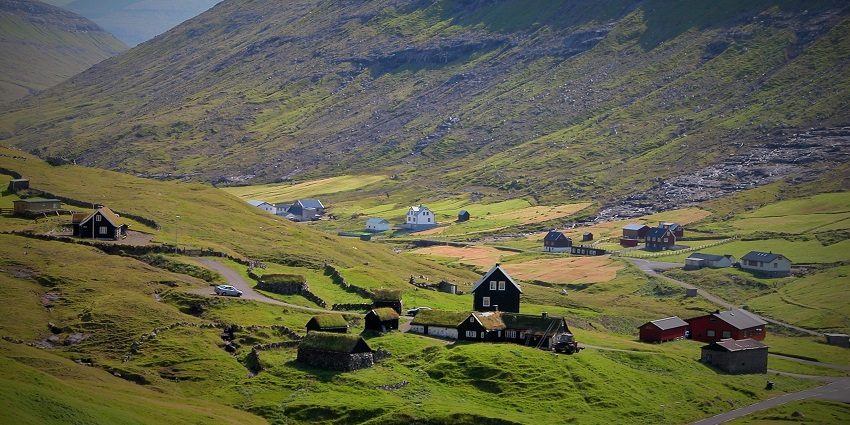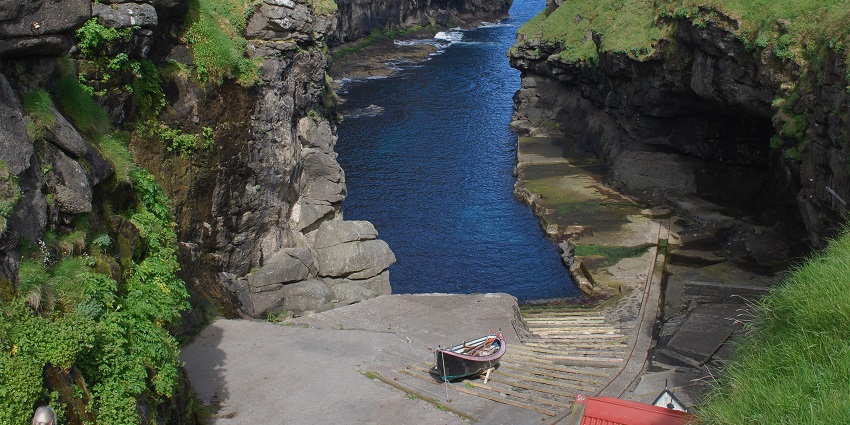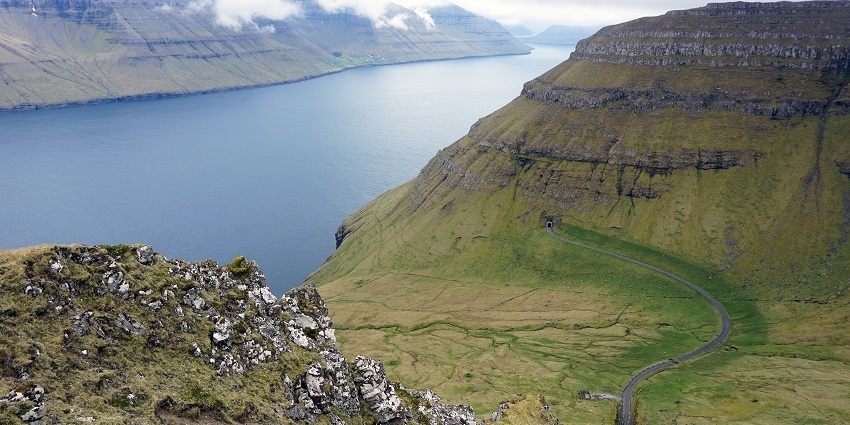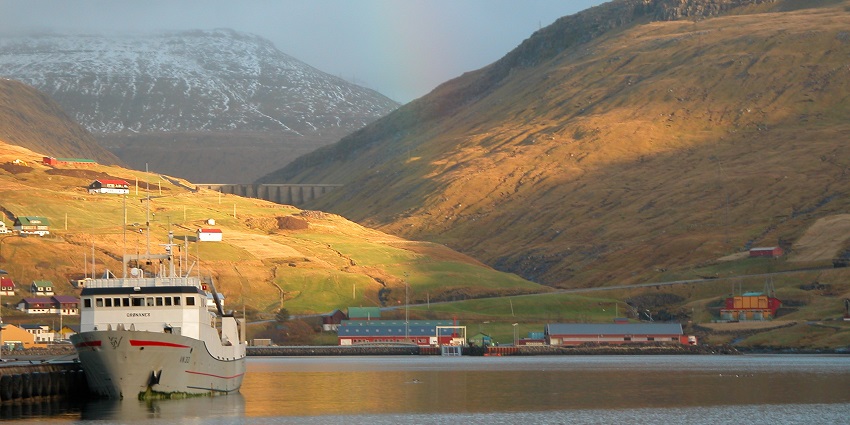These places to visit on the Faroe Islands offer a unique experience that plays out in the dramatic scenery of the archipelago combined with its rich culture and ecotourism. t Visitors cannot get enough of the rugged cliffs, undulating green hills, and pervasive fickle weather, all of which create an atmosphere of endlessly untouched natural beauty. The Faroese way of life- anchored, inextricably, in nature and traditions – gives a feel of complete immersion in cultural experience through local food, music, and crafts. This permits every visitor to have the freedom to enjoy that very unique quintessence of truly national beauty while ensuring the fragile environment remains intact.
Top 10 Places To Visit On The Faroe Islands
The Faroe Islands offer breathtaking landscapes, dramatic cliffs, and charming villages. Here are ten must-visit places strictly within the archipelago:
1. Saksun

Photo: Erik Christensen / Wikimedia Commons
Known for its incredible scenery and old-world charm, Saksun is a remote village on the Faroe Islands. Tucked into a valley surrounded by steep hills, it presides over an inlet that was once a natural harbour until being sealed off by a storm in the seventeenth century. The village has the 19th-century Saksun Church and the Dúvugarðar farm, a museum of traditional Faroese life. There are some great hiking trails, with views of surrounding fjords and waterfalls. The lagoon changes dramatically with the tide, giving it even more aesthetic appeal. Though small, Saksun immerses the traveller in an experience of the natural beauty and culture of the Faroe Islands-a veritable haven of peace where exceptional landscapes invite a visit.
Location: Northwestern Streymoy Island
2. Gjogv

Photo: Erik Christensen / Wikimedia Commons
The village of Gjógv on the northeastern coast of Eysturoy gets its name from the prominent 200-meter sea-deep gorge that runs through it. The natural harbor enclosed by the gorge gave fishermen safe passage to the open sea in the past and is now no longer used. The village boasts brightly coloured turf-roofed houses with breathtaking views across the mountains and the ocean. An uphill walk to the nearby cliffs provides great panoramic views and has become a popular destination for photographers and nature lovers. The area has also been blessed with a lot of avian birds, such as puffins and other seabirds that nest on those very cliffs.
Location: Northeastern tip of Eysturoy Island
3. Mykines

Photo: Stefan Wisselink / Wikimedia Commons
Mykines is the westernmost of the islands in the Faroe Islands. This little island is like a birdwatchers’ and nature enthusiasts’ paradise. Famous for its nesting puffin colonies, Mykines is also home to the small but important gannetry on Mykineshólmur, an islet connected with Mykines by a footbridge and is known only for the summers of the past when thousands of puffins would swarm in the grassy cliffs rimming the island to breed. The dramatic landscape of the island consists of steep cliffs and rolling green hills and catches the famous Mykines Lighthouse, guiding ships long since 1909. Boat or helicopter access only, Mykines is as undisturbed as anything. Numbers of visitors are restricted due to the fragile ecosystem.
Location: Westernmost of the Faroe Islands.
4. Tjornuvík

Photo: Erik Christensen / Wikimedia Commons
Tjørnuvík is one of the oldest and most scenic villages in the Faroe Islands and is located on the north coast of Streymoy. The village is located among impressive mountains and on the open North Atlantic, as it faces the dramatic sea stacks, Risin and Kellingin, which are petrified giants according to Faroese legend. Tjørnuvík is also a quite uncommon black sand beach in the Faroes that draws surfers because of its tumultuous waves. The village is crawling with Viking heritage as burial sites found there came alive to tell what the first inhabitants of the islands were like. Tjørnuvík, while being quite small, has a way of proving unforgettable, bringing nature, folklore, and adventure all into one of the most beautiful places in the Faroe Islands.
Location: Northern coast of Streymoy Island
5. Kirkjubøur

Photo: Vincent van Zeijst / Wikimedia Commons
Kirkjubøur is the most historically significant village in the Faroe Islands on the southern tip of Streymoy. It was the ecclesiastical and cultural center of the islands in the Middle Ages and remains home to some of the most important historical sites. The ruins of Magnus Cathedral, built in the 13th century, are an unfinished relic of medieval church architecture. Not far away is the 12th-century-built St. Olav’s Church, still in use today and among the most ancient churches in the Faroes. In Kirkjubøur, we also find Roykstovan, believed to be the oldest house of timber, inhabited conditionally since 17 generations by this Faroese family.
Location: Southern Streymoy Island, near Tórshavn
6. Lake Sorvagsvatn

Photo: Ekrem Canli / Wikimedia Commons
Lake Sørvágsvatn (Leitisvatn) is by far the largest lake in the Faroe Islands, and one of its most iconic natural wonders. Being located on the island of Vágar, this lake is famous for its optical illusion, which portrays it as floating high above the ocean. This effect can be best appreciated from the Trælanípa cliffs, owing to the steep drop from lake to sea that only enhances this illusion. The lake is approximately six kilometers long, at the end of which lies Bøsdalafossur, with its waterfall crashing straight into the Atlantic Ocean. In Faroese folklore, the region is rich with stories of legend, one of which tells of slaves being pushed from the cliffs of Trælanípa. Hiking around Sørvágsvatn gives panoramic views of the coastline and the nearby islands.
Location: Vágar Island
7. Kalsoy Island

Photo: kallerna / Wikimedia Commons
With its narrow shape and its length of tunnels, it has one of the most striking islands in Faroes- Kalsoy. In this northern part of the archipelago, the most famous spot is the Kallur Lighthouse, which perches precariously on a cliff edge and provides stunning views across the North Atlantic. This hike will lead you to one of the most rewarding destinations in these islands: breathtaking scenery and vertical drops. Kalsoy is not only a beautiful island but also rich in folklore, much of it around the legend of The Selkie (Seal Woman), the subject of a statue in the village of Mikladalur. Kalsoy can be reached only by ferry from Klaksvik, and there are single-track tunnels connecting small villages.
Location: Northeastern Faroe Islands
8. Vestmanna Bird Cliffs

Photo: Erik Christensen / Wikimedia Commons
Vestmanna Bird Cliffs, situated on the western side of the island of Streymoy, are some of the greatest natural wonders anywhere in the Faroe Islands. These cliffs are towering formations from 600 meters down to sea level that provide a nesting site for half-a-dozen different seabird species, including thousands of puffins, guillemots, and fulmars. Cliffs are exclusively traveled by boat, with guided excursions through narrow sea stacks and extensively deep grottos, permitting fantastic close-ups of birds and dramatic cloistered rock formations. Historically, this area was significant for the Faroese bird hunters who used to climb the cliffs with ropes to gather eggs and birds. Today, the cliffs are a protected wildlife area attracting nature lovers and aspiring photographers.
Location: Near Vestmanna village on Streymoy Island
9. Torshavn

Photo: Stig Nygaard / Wikimedia Commons
Tórshavn is one of the tiniest capitals in the world. However, it is quite an intriguing city as it is a combination of history, culture, and present-day Faroese living. Lying on the eastern coast of Streymoy, it is home to Tinganes, a historic site that contains red wooden governmental buildings dating back to the Viking Age. The National Museum and Nordic House will tell you how Faroese history, culture, and art play out in this island nation. The harbour area of Tórshavn comes with comfortable cafés, seafood restaurants, and shops offering local handicrafts and woollen goods. It is a setting for presentations of Faroese music and literature, highlighted by its plethora of festivals and cultural events.
Location: Southeastern coast of Streymoy Island
10. Funningur

Photo: Ekrem Canli / Wikimedia Commons
Funningur is the village where the first Norse settlers landed in the Faroe Islands. It is located on the island of Eysturoy, at the edge of a fjord, and nature casts an exuberant spirit of lofty mountains upon Funningur. With a great view of the fjord and surrounding mountains, it is from Funningur that the hike to Slættaratindur, the highest mountain in the Faroes at 880 meters, starts. Therefore, the village has traditional turf houses with a quaint wooden church built in 1847. The roads leading to Funningur have some intricate winding trails that boast of some of the most dramatic scenery in the Faroes; hence, you will not only reach the place but enjoy getting there.
Location: Eastern coast of Eysturoy Island
Situated far to the northwest of Europe, the Faroe Islands are undoubtedly a fine contrast to a land of natural ruggedness, deep-seated history, and cultural charm, making every memory of a visit worthwhile. From monster-skipping cliffs to faraway villages and tranquil lakes, every inch of the carpet begs exploration. Whether you seek adventure or serenity or want to catch a glimpse of Faroese tradition, the islands offer an experience like no other. With TripXL, your trustworthy travel partner offering tailor-made itineraries, guided tours, and hassle-free bookings, it’s easy to plan your trip.
Cover Photo: Mirek237 / Wikimedia Commons


 WhatsApp
WhatsApp
 Twitter
Twitter









